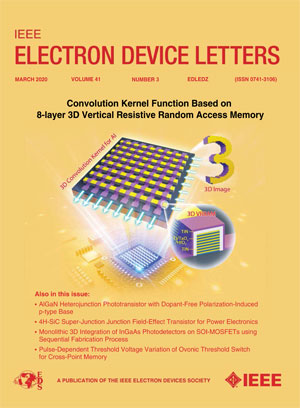Hybrid Integrated Lead-Free Perovskite/Graphene Array Toward High-Responsivity In-Sensor Computing
IF 4.1
2区 工程技术
Q2 ENGINEERING, ELECTRICAL & ELECTRONIC
引用次数: 0
Abstract
Perovskite are expected to construct vision neuromorphic systems due to its unique photoelectric properties. However, the ion migration in perovskite films, as well as the toxicity of lead element limit their applications. Here we demonstrated a lead-free perovskite-graphene hybrid (PGH) integrated device via low temperature method. This hybrid structure decouples vertical carrier extraction under built-in electric field and horizontal carrier transport under applied high electric filed, which enhances carrier transport efficiency while alleviating ion migration issues. As a result, a responsivity of 199 A/W and a detectivity of无铅过氧化物/石墨烯混合集成阵列,实现高共振频率传感计算
由于其独特的光电特性,人们期待用包晶石构建视觉神经形态系统。然而,透镜薄膜中的离子迁移以及铅元素的毒性限制了其应用。在这里,我们通过低温方法展示了一种无铅包晶石-石墨烯混合(PGH)集成器件。这种混合结构将内置电场下的垂直载流子萃取和外加高电场下的水平载流子传输分离开来,从而提高了载流子传输效率,同时缓解了离子迁移问题。因此,其响应率达到 199 A/W ,检测率达到 ${0}.{53}\times {10}$ ^{{10}}$ 。在 405 纳米光照下(功率强度:${0}.{24}/times {10}}$ Jones),实现了 199 A/W 的响应率和 ${0}.{53}\times {10}} 的检测率。nW/ $\mu $ m $^{{2}}\text {)}$ 。此外,PGH 波段排列中的电荷捕获/俘获所引起的基态电流漂移有助于对视觉信息进行原位预处理。我们构建了一个具有 ${6}\times {6}$ 传感器阵列的神经形态视觉系统,它在识别任务中的准确率显著提高(69.2% 至 89.5%)。这项工作有助于开发基于包晶的高性能神经形态器件。
本文章由计算机程序翻译,如有差异,请以英文原文为准。
求助全文
约1分钟内获得全文
求助全文
来源期刊

IEEE Electron Device Letters
工程技术-工程:电子与电气
CiteScore
8.20
自引率
10.20%
发文量
551
审稿时长
1.4 months
期刊介绍:
IEEE Electron Device Letters publishes original and significant contributions relating to the theory, modeling, design, performance and reliability of electron and ion integrated circuit devices and interconnects, involving insulators, metals, organic materials, micro-plasmas, semiconductors, quantum-effect structures, vacuum devices, and emerging materials with applications in bioelectronics, biomedical electronics, computation, communications, displays, microelectromechanics, imaging, micro-actuators, nanoelectronics, optoelectronics, photovoltaics, power ICs and micro-sensors.
 求助内容:
求助内容: 应助结果提醒方式:
应助结果提醒方式:


